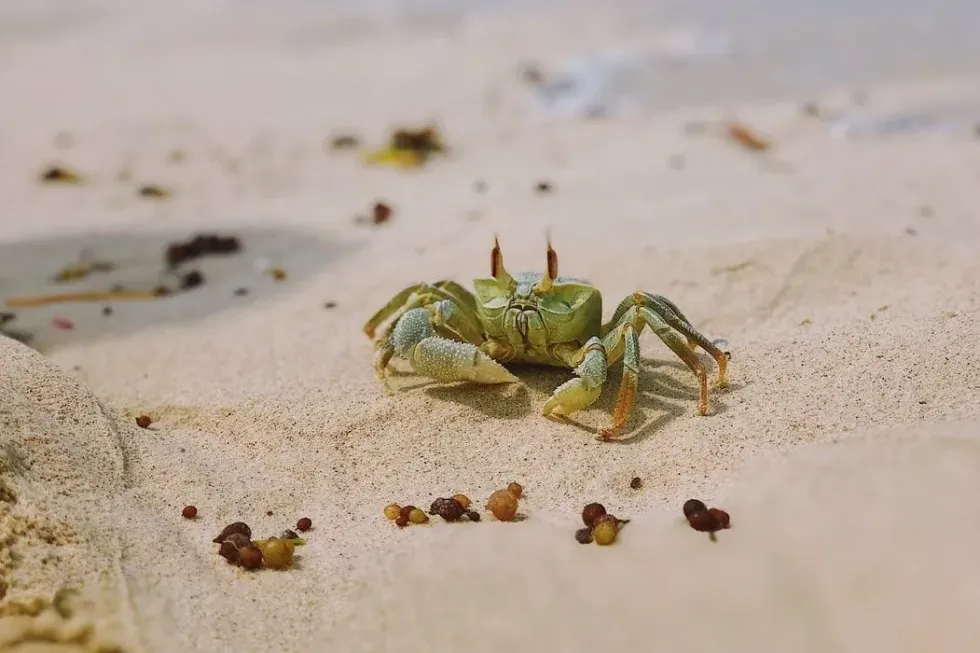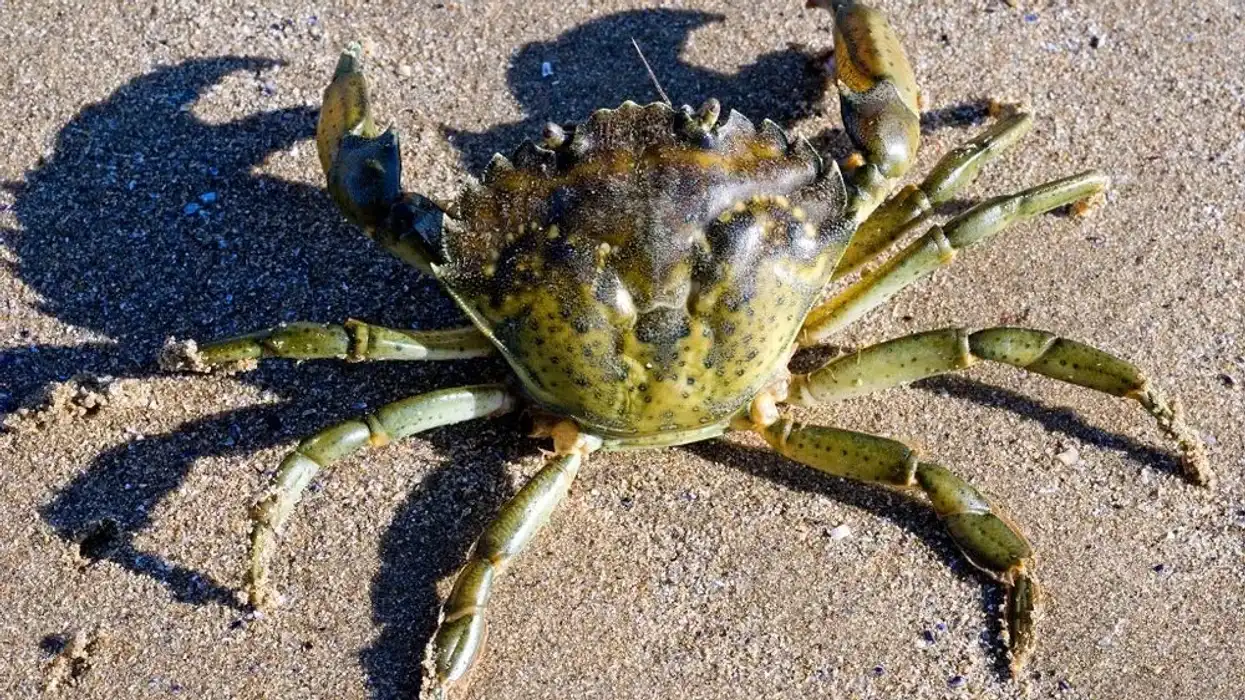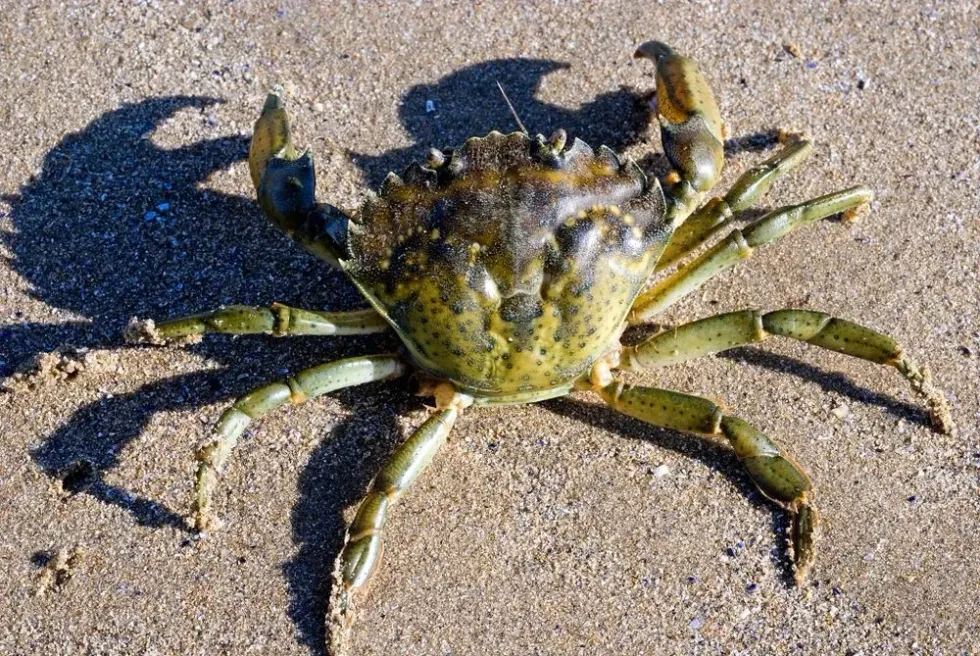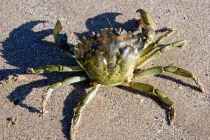Fun Green Crab Facts For Kids

Content
- What type of animal is a green crab?
- What class of animal does a green crab belong to?
- How many green crabs are there in the world?
- Where does a green crab live?
- What is a green crab's habitat?
- Who do green crabs live with?
- How long does a green crab live?
- How do they reproduce?
- What is their conservation status?
- What do green crabs look like?
- How cute are they?
- How do they communicate?
- How big is a green crab?
- How fast can a green crab run?
- How much does a green crab weigh?
- What are their male and female names of the species?
- What would you call a baby green crab?
- What do they eat?
- Are they dangerous?
- Would they make a good pet?
- Did you know...
- How does the European green crab affect the ecosystem?
- What eats the green crab?
The Carcinus maenas (green crab scientific name) is a small shore crab with native distribution in the Baltic Sea and the northeast Atlantic Ocean, ranging along the coasts from Iceland, Norway to northern Africa.
This crab is known to be an effective predator who is an expert in opening bivalve shells. They have also been blamed for the downfall of the US East Coast’s softshell clam industry.
Since they prey on a multitude of organisms, they have become a potential competitor for the food sources of native bird and fish species.
There are several other common names for the Green crab. In Europe, it is known of only as the ‘shore crab’ since it is the most common shore crab species in the native region.
In the Pacific Northwest region, the ‘shore crab’ is the Hemigrapsus species. The Latin name of the green crab ‘Carcinus maenas’ literally translates to ‘raving mad crab’. The French call this crab ‘le crabe enragé’ and ‘le crabe vert’.
The name of the green crab in Germany is ‘beach crab’ or ‘strandkrabbe’. But, the coolest name for the green crab is ‘Joe rocker’ that is commonly used in Europe.
Since they are mostly found on beaches, the European green crab, Carcinus maenas, are exposed frequently to the receding tides. You can find adult crabs foraging on the subtidal shore, staying submerged most of the time, and following the tide.
However, during the colder months, the large juveniles and adults will migrate into the deeper waters while the juveniles stay in the harsh intertidal zone and burrow under the marsh grasses and rocks throughout the year.
The European green crab, Carcinus maenas, species is capable of tolerating different environmental extremes in the intertidal zones such as low salinities, drying out, and cold temperature. Read on for green crab facts.
You may also like our fact files on hermit crab and King crab.
Green Crab Interesting Facts
What type of animal is a green crab?
The green shore crab is an invasive species of the crab found in the Pacific Northwest and as far north as BC (British Columbia). However, they are not known to be found in Alaska.
Also known as the European shore crab, the European green crab is a small and aggressive marine shore crab that can be found in the estuarine and rocky intertidal areas. And, even though the common name of the crab might lead you to believe that they are always green, their coloration can vary.
Adults are usually dark greenish in color with yellow markings and some orange at the joint. In fact, juveniles can even change their color to match the surroundings while they molt.
What class of animal does a green crab belong to?
The green crab invasive species from the sea belongs to the class Malacostraca, a Crustacean's major subclass that includes some of the most popular terrestrial, freshwater, and marine members of the group including crabs, lobsters, shrimps, beach fleas, and sow bugs.
How many green crabs are there in the world?
An accurate figure for the total of green crabs in the world is unknown.
Where does a green crab live?
Since the green crab (European) is also known as shore crab, it means that it usually lives on marshes and beaches instead of the deeper waters of the sea in the aquatic and equestrian ecosystem. The green crab can be found in the muddy shoreline habitats of the Pacific Northwest such as pocket estuaries and salt marshes.
Thanks to the equestrian and aquatic environments, the green crab European gets protection from larger predatory species such as rock crabs and Dungeness that are known to prey on European green crabs.
What is a green crab's habitat?
The European green crab’s habitat is a marsh, a wetland dominated by herbaceous instead of woody plant species. They can be found at the edges of streams and lakes, not the sea where they are a part of the transition between the terrestrial and aquatic ecosystem. They are usually dominated by rushes, reeds, and grasses.
Who do green crabs live with?
A European green crab lives cooperatively in a group. They work together for providing food and protection to their families.
How long does a green crab live?
The average age for a European green crab is four to seven years. It is capable of tolerating a wide range of salinities (salt content) and water temperature.
Also, females can release about 185,000 eggs in a year. Their larval stage or early life can be somewhere between 50-80 days when they drift with the ocean current and settle to the bottom.
How do they reproduce?
The female green crabs are capable of producing about 185,000 eggs at a time. Once a year, females molt, during which they are very vulnerable.
During this time and until their new shell hardens, the male crab will guard the female crab by pairing with them in the formation of ‘pre-molt cradling’. This way, they are able to defend themselves from other males and predators.
The European green crab mates during summer’s end in the water. A couple of months after they have mates, the egg sacs.
The females carry the sacs all the way through the winter and spring seasons. Then, around May or June, the females release the hatchlings in the form of free-swimming plankton larvae moving with the tides of the water column.
This continues for about 17-80 days until they settle to the bottom of the water body.
The green crab larvae will be spending their first summer going through several stages until they become megalopa - adult crabs’ mini version that has a tail for swimming. During the final molt, they lose this tail and come out as a juvenile crab with a 2 mm carapace.
What is their conservation status?
There is no conservation currently underway for the green crab as they are considered a Not Endangered species.
Green Crab Fun Facts
What do green crabs look like?
Even though they are most popularly known by the name European green crab, their most distinguishing feature is not their color. The carapace color might vary widely.
Adults are usually of a dark greenish color with yellow markings and some orange at the joints while juveniles are capable of changing their color and matching their surroundings every time they molt. The underside of the green crab is off-white, but can also be bright yellow or red.
In terms of the shape of the crab, their back shell has more width at the front than at the back. This can be compared to the Hemigrapsus oregonensis or Oregon shore crab’s square shell.
The best way for you to identify this crab from other species is through the number of spines present next to the eye or through marginal teeth. Since it has five marginal teeth, it sets the green crab entirely apart from other native crabs.
Compared to the main body, the legs of the green crab are relatively long. Also, they have narrow crabs. Since this species belongs to the family of swimming crabs, the last pair of legs have been slightly flattened.

How cute are they?
They are kind of cute for a crab, mainly because of their green color.
How do they communicate?
European green crabs communicate through sound. They make flapping and drumming sounds by using their pincers and claws.
How big is a green crab?
The carapace width of a European green crab is about 2.5 in long. But, outside of its native range, it can range up to 4 in.
How fast can a green crab run?
Despite having long legs, the green crab is not known to be a strong swimmer. It can crawl through the sand but its speed is not known.
How much does a green crab weigh?
There is not much known about the weight of this crab, however, there are studies to suggest that the carapace of the crab could weigh anywhere between 2.2-41.3 g depending on the gender and location of the crabs.
What are their male and female names of the species?
There are no distinct names for each gender of this species. They are simply referred to as male green crabs and female green crabs.
What would you call a baby green crab?
The young of this species are just baby green crabs. In general, the offspring of crabs are called zoea, so baby green crabs can also be referred to as such.
What do they eat?
The green crab can eat several organisms including oysters, clams, marine worms, mussels, and small crustaceans.
Are they dangerous?
This crab (European green) is not dangerous, however, it can be harmful to the ecosystem it inhabits as it is a fierce predator and can disturb the food chain in the waters and the aquatic life on the seabeds.
Would they make a good pet?
Crabs can be a good family pet. However, you do have to take proper care of them and feed them properly to ensure that they will be your companion for several years to come.
Did you know...
The green crab populations have been affected by global warming. Up until recently, cold winters were able to balance the proliferation of European green crabs in the American coastal waters.
But, thanks to the onset of warmer summers, they have been continuing to rise in numbers. Warmer climates have been connected to an upswing in the growth cycle of a green crab.
Between 1979-1980, a professor named Micheal Berrill from the Trent University in Peterborough, Ontario Canada was researching the conservation, behavioral ecology, and the impact of environmental stresses on the survival of the species. He observed the mating cycles and growth rate of green crabs in the coastal waters near Maine.
If you compare his findings with the recent studies, you will find that because of the prolonged growing season and more months with warm water temperatures, the green crabs have been growing larger.
This change in the growth rate is affecting the mating cycle as well. Female green crabs reach sexual maturity when they reach a certain size, not when they reach a specific age.
Research has shown that the female green crabs reproduce usually in their third year. But, with the faster growth cycles and warmer waters, female crabs have started to reproduce in their second year.
This has resulted in a rapid increase in the green crab populations which has put certain species at risk. According to the Maine Community Science Investigations, this population increase might be devastating to the species on which these crabs pre such as soft shell clam.
The European green crab invasive species has invaded several coastal communities that were outside of its native range such as both coasts of North America, South Africa, Australia, and Brazil. An efficient predatory and able colonizer, this shore crab might look small but can alter any ecosystem significantly that it invades.
In fact, it has already been blamed for the soft shell clam industry collapse in Maine. Over time, they might also threaten Dungeness crab, aquaculture operations, clam fisheries, and oysters in the British Columbia and Pacific Northwest region.
The European green crab preys on a wide range of organisms including small crustaceans, clams, mussels, oysters, and marine worms. But, since it also preys on shellfish and juvenile crabs, a northward spread to Puget Sound and Washington coats can put the Dungeness crab, oyster fisheries, and clams at risk.
Also, they might compete with native bird and fish species for food. Apart from this, they are also an intermediate host to the marine worm capable of harming the local shorebirds’ health.
How does the European green crab affect the ecosystem?
The European green crab is a voracious predator that poses a serious threat to marine and estuarine ecosystems. They feed on a wide range of intertidal animals such as juvenile crabs, oysters, clams, and mussels.
They are also responsible for changing the balance between different species in the ecosystem and impacting their diversity. In fact, their predatory skills are so efficient that they can out-compete even the native crab species for food.
Green crabs are also known for disrupting eelgrass beds (habitat for several species of juvenile fish) and destroying beds of bivalve shellfish. Because of their huge appetite, fierce competition with other species, and huge appetite, they are a threat to crustaceans, fish, and mollusks.
Unless their population is controlled, they will continue having a significant impact on the habitat and biodiversity of marine and equestrian ecosystems.
What eats the green crab?
Green crabs, an invasive species, are consumed as food in several regions all over the globe, especially in Venice, Italy where crabs are a native species. Also, Venetian cuisine has been utilizing the European green crab in thor dishes for a long time, either shucked, soft-shell, or in a caviar dish called Masinette.
They are also eaten by large predatory species like Dungeness and rock crabs.
Here at Kidadl, we have carefully created lots of interesting family-friendly animal facts for everyone to discover! Learn more about some other arthropods including Dungeness crab, or Sally Lightfoot crab.
You can even occupy yourself at home by drawing one on our Green crab coloring pages.
We Want Your Photos!
More for You
Sources
https://csi-maine.org/2018/08/30/the-green-crab-lifecycle/
https://animaldiversity.org/accounts/Carcinus_maenas/
https://en.wikipedia.org/wiki/Carcinus_maenas
Bachelor of Arts and Law specializing in Political Science and Intellectual Property Rights

Anusuya MukherjeeBachelor of Arts and Law specializing in Political Science and Intellectual Property Rights
With a wealth of international experience spanning Europe, Africa, North America, and the Middle East, Anusuya brings a unique perspective to her work as a Content Assistant and Content Updating Coordinator. She holds a law degree from India and has practiced law in India and Kuwait. Anusuya is a fan of rap music and enjoys a good cup of coffee in her free time. Currently, she is working on her novel, "Mr. Ivory Merchant".
Bachelor of Journalism and Mass Communication

Ankit ShindeBachelor of Journalism and Mass Communication
Ankit is a Journalism and Mass Media graduate from the University of Mumbai. With experience in SEO, blog and article writing, and fiction writing, he is a versatile writer and content creator. In his free time, Ankit enjoys reading, writing, and listening to music.
Disclaimer
1) Kidadl is independent and to make our service free to you the reader we are supported by advertising. We hope you love our recommendations for products and services! What we suggest is selected independently by the Kidadl team. If you purchase using the Buy Now button we may earn a small commission. This does not influence our choices. Prices are correct and items are available at the time the article was published but we cannot guarantee that on the time of reading. Please note that Kidadl is a participant in the Amazon Services LLC Associates Program, an affiliate advertising program designed to provide a means for sites to earn advertising fees by advertising and linking to Amazon. We also link to other websites, but are not responsible for their content.
2) At Kidadl, we strive to recommend the very best activities and events. We will always aim to give you accurate information at the date of publication - however, information does change, so it’s important you do your own research, double-check and make the decision that is right for your family. We recognise that not all activities and ideas are appropriate for all children and families or in all circumstances. Our recommended activities are based on age but these are a guide. We recommend that these ideas are used as inspiration, that ideas are undertaken with appropriate adult supervision, and that each adult uses their own discretion and knowledge of their children to consider the safety and suitability. Kidadl cannot accept liability for the execution of these ideas, and parental supervision is advised at all times, as safety is paramount. Anyone using the information provided by Kidadl does so at their own risk and we can not accept liability if things go wrong.
3) Because we are an educational resource, we have quotes and facts about a range of historical and modern figures. We do not endorse the actions of or rhetoric of all the people included in these collections, but we think they are important for growing minds to learn about under the guidance of parents or guardians.







